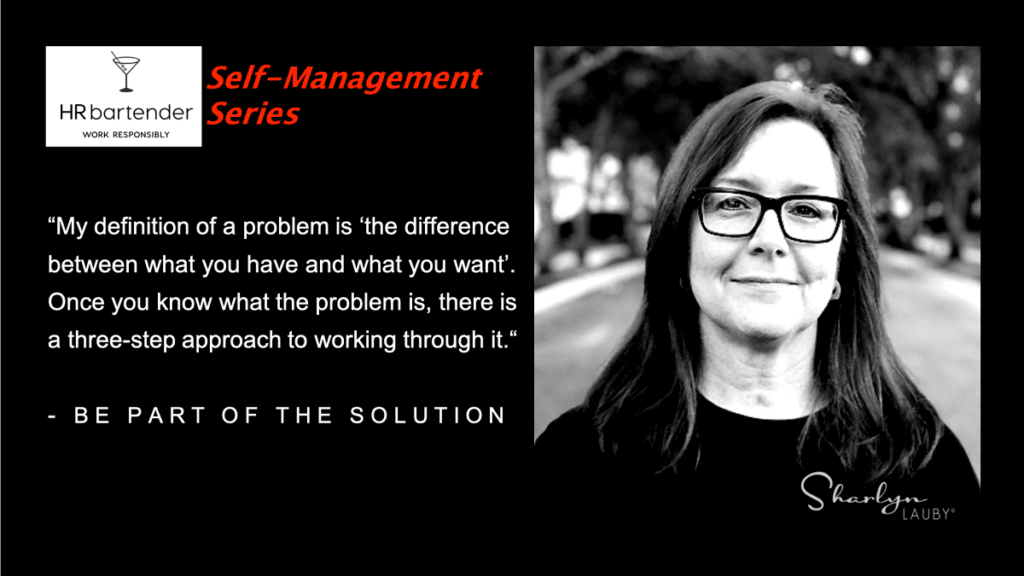Be Part of the Solution – Part 3, Self Management Series

One of the things I miss about working in an office environment is the camaraderie. Especially when I’m faced with a problem. I can leave my office or cubicle and find someone to talk to or help me figure out a solution.
While we can do that to some extent working from home or the local coffee shop, it’s not the same. It’s not as easy to just pick up the phone and chat with a co-worker. In a self-managing work environment, we have to work through our problems on our own.
The first step in solving a problem is understanding whether the situation we’re faced with is really a problem. In the book “Polarity Management: Identifying and Managing Unsolvable Problems,” author Dr. Barry Johnson talks about the differences between problems and polarities. His theory is that sometimes we try to use a problem-solving approach seeking a solution on something that’s really not a problem at all.
My definition of a problem is “the difference between what you have and what you want.” Examples of problems include: “How do I get to the Florida Turnpike?” or “Should we merge with XYZ Company?” In these instances, once you get to the Turnpike or merge (or not) with XYZ Company, the problem is solved.
By contrast, a polarity occurs when you have two opposing forces. For example, centralization versus decentralization is a polarity. This is a polarity because neither centralization or decentralization are wrong – they are just two different approaches. And even when you choose one, you still have ongoing dynamics to deal with (translation: it’s not over.) Dr. Johnson elaborates in his book how polarities are not problems and the specifics of how to manage the opposing forces of a polarity. It’s a fascinating read.
But for now, let’s focus on problems and solutions. If you’ve analyzed the situation and know you have a problem, here’s a three-step approach to working through it. It’s known as the STP model of problem-solving. STP is an acronym for Situation – Target – Proposal. As you’re reading through the rest of this article, think about a problem that you’re currently experiencing. You can ask yourself the following questions:
Step One: Assess the SITUATION
During the Situationphase, you have the opportunity to examine the circumstances. Ask yourself the “who, what, where, when, why” questions to fully understand the matter. Also, don’t forget to ask questions about the extent of the problem, any patterns that might exist, and what the cause is. You’re able to collect any relevant information, understand the dynamics of the problem, and the possibilities in terms of changing the situation. Using one of the examples above, you’re driving along and realize you need to be on the Florida Turnpike. Congratulations, you know the situation.
Step Two: Identify the TARGET
The next phase allows you to identify the Target, or the end to the problem (i.e. arriving at the Florida Turnpike). This is ultimately what you want to accomplish or your vision of what would happen if the problem were solved. Identifying the Target will also help to clarify the issues involved in solving the matter. You can also see if there is anything you would like to avoid – like getting lost along the way or maybe not getting a speeding ticket.
Step Three: Generate PROPOSALS
Now that you’ve accurately assessed the problem and determined the Target, use the Proposal step as a way to prepare the action plan to solve the situation. This is when you generate ideas and develop a plan to solve the problem. Examples would be using your GPS, downloading a map on your phone, or stopping for directions.
The STP model is a systematic method that can guide you through any type of problem.
In the first two articles of this series, we talked about knowing ourselves and doing meaningful work. Being able to solve problems adds another layer to our self-management competencies. When we’re able to understand our strengths and weaknesses and apply those in the context of work, it helps us correctly assess, develop and implement a solution to the problems we face.
This is a skill we need whether we work in an office or remotely. But right now, as many of us spend more time working on our own, it becomes particularly valuable.
But you might be asking yourself, “What happens when that ‘problem’ is another person?” Well, that’s our next self-management quality – conflict management.
12